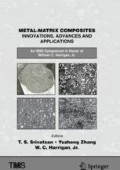Abstract
A contactless excitation of cavitation is possible by superposition of induction heating with a static axial magnetic field. This creates an alternating electromagnetic body force in a liquid metal which in turn produces pressure oscillations. Using this method, the onset of cavitation has been clearly observed in various liquid metals (tin, zinc, aluminum, steel SAE 304) at pressure oscillations in the range of 28…50 kPa. The present study aims to extend the previous work by producing steel metal matrix composites (MMC) and assessing the feasibility of the proposed method for particle dispersion in steel. Stainless steel (SAE 316L) samples with different ceramic inclusions, e.g. TiN, Al2O3, TiB2 as well as others, have been created. It has been demonstrated that the cavitation onset in the liquid steel varies extensively and depends on the cavitation nuclei rather than the strength of acoustic pressure. The microstructure of the produced samples has been analyzed using SEM and EDS.
Access this chapter
Tax calculation will be finalised at checkout
Purchases are for personal use only
References
Tahamtan S, Emamy M, Halvaee A (2014) Effects of reinforcing particle size and interface bonding strength on tensile properties and fracture behavior of Al-A206/alumina micro/nanocomposites. J Compos Mater 48(27):3331–3346. https://doi.org/10.1177/0021998313509860
Sharifi H, Nasresfahani MR (2016) Investigation into the kinetic behavior of molten aluminum pressureless infiltration into SiC preforms. Int J Mater Res 107(10):954–959. https://doi.org/10.3139/146.111422
Lü SL, Xiao P, Wu SS, Fang XG (2017) Preparation and squeeze casting of nano-SiCP/A356 composite assisted with ultrasonic vibration process. Mater Sci Forum 879:1188–1193. doi:https://doi.org/10.4028/www.scientific.net/MSF.879.1188
Yan H, Huang Z-X, Qiu H-X (2017) Microstructure and mechanical properties of CNTs/A356 nanocomposites fabricated by high-intensity ultrasonic processing. Metall Mater Trans A 48(2):910–918. https://doi.org/10.1007/s11661-016-3872-1
Chen L-Y, Xu J-Q, Choi H, Pozuelo M, Ma X, Bhowmick S, Yang J-M, Mathaudhu S, Li X-C (2015) Processing and properties of magnesium containing a dense uniform dispersion of nanoparticles. Nature 528(7583):539–543. https://doi.org/10.1038/nature16445
Braszczyńska-Malik KN, Kamieniak J (2017) AZ91 magnesium matrix foam composites with fly ash cenospheres fabricated by negative pressure infiltration technique. Mater Charact 128:209–216. https://doi.org/10.1016/j.matchar.2017.04.005
Zhang X, Zhang Q, Hu H (2014) Tensile behaviour and microstructure of magnesium AM60-based hybrid composite containing Al2O3 fibres and particles. Mater Sci Eng A 607:269–276. https://doi.org/10.1016/j.msea.2014.03.069
Wang XJ, Wang NZ, Wang LY, Hu XS, Wu K, Wang YQ, Huang YD (2014) Processing, microstructure and mechanical properties of micro-SiC particles reinforced magnesium matrix composites fabricated by stir casting assisted by ultrasonic treatment processing. Mater Des 57:638–645. https://doi.org/10.1016/j.matdes.2014.01.022
Li S, Sun B, Imai H, Mimoto T, Kondoh K (2013) Powder metallurgy titanium metal matrix composites reinforced with carbon nanotubes and graphite. Compos A Appl Sci Manuf 48(1):57–66. https://doi.org/10.1016/j.compositesa.2012.12.005
Munir KS, Zheng Y, Zhang D, Lin J, Li Y, Wen C (2017) Improving the strengthening efficiency of carbon nanotubes in titanium metal matrix composites. Mater Sci Eng A 696:10–25. https://doi.org/10.1016/j.msea.2017.04.026
Dubuisson P, Carlan YD, Garat V, Blat M (2012) ODS ferritic/martensitic alloys for sodium fast reactor fuel pin cladding. J Nucl Mater 428(1–3):6–12. https://doi.org/10.1016/j.jnucmat.2011.10.037
Franke P, Heintze C, Bergner F, Weißgärber T (2010) Mechanical properties of spark plasma sintered Fe-Cr compacts strengthened by nanodispersed yttria particles. Materialpruefung/Mater Test 52(3):133–138
Bonnet F, Daeschler V, Petitgand G (2014) High modulus steels: new requirement of automotive market. How to take up challenge? Can Metall Q 53(3):243–252. https://doi.org/10.1179/1879139514Y.0000000144
Springer H, Baron C, Szczepaniak A, Uhlenwinkel V, Raabe D (2017) Stiff, light, strong and ductile: nano-structured high modulus steel. Sci Rep 7(1) (art.no.2757). https://doi.org/10.1038/s41598-017-02861-3
Bittmann B, Haupert F, Schlarb AK (2009) Ultrasonic dispersion of inorganic nanoparticles in epoxy resin. Ultrason Sonochem 16(5):622–628. https://doi.org/10.1016/j.ultsonch.2009.01.006
Sumitomo S, Koizumi H, Uddin MA, Kato Y (2018) Comparison of dispersion behavior of agglomerated particles in liquid between ultrasonic irradiation and mechanical stirring. Ultrason Sonochem 40:822–831. https://doi.org/10.1016/j.ultsonch.2017.08.023
Suslick KS, Didenko Y, Fang MM, Hyeon T, Kolbeck KJ, McNamara III, WB, Mdleleni MM, Wong M (1999) Acoustic cavitation and its chemical consequences. Philos Trans R Soc A: Math Phys Eng Sci 357(1751):335–353
Vivès C (1996) Crystallization of aluminium alloys in the presence of cavitation phenomena induced by a vibrating electromagnetic pressure. J Cryst Growth 158(1–2):118–127
Grants I, Gerbeth G, Bojarevičs A (2015) Contactless magnetic excitation of acoustic cavitation in liquid metals. J Appl Phys 117(20) (art.no.204901). https://doi.org/10.1063/1.4921164
Sarma M, Grants I, Kaldre I, Bojarevics A, Gerbeth G (2017) Casting technology for ODS steels—dispersion of nanoparticles in liquid metals. IOP Conf Series: Mater Sci Eng 228(1):012020. https://doi.org/10.1088/1757-899X/228/1/012020
Abramov OV (1987) Action of high intensity ultrasound on solidifying metal. Ultrasonics 25(2):73–82. https://doi.org/10.1016/0041-624X(87)90063-1
Neppiras EA (1980) Acoustic cavitation. Phys Rep 61(3):159–251. https://doi.org/10.1016/0370-1573(80)90115-5
Cramer E, Lauterborn W (1982) Acoustic cavitation noise spectra. Appl Sci Res 38(1):209–214. https://doi.org/10.1007/BF00385950
Aparicio-Fernández R, Springer H, Szczepaniak A, Zhang H, Raabe D (2016) In-situ metal matrix composite steels: effect of alloying and annealing on morphology, structure and mechanical properties of TiB2 particle containing high modulus steels. Acta Mater 107:38–48. https://doi.org/10.1016/j.actamat.2016.01.048
Acknowledgements
The financial support of the Helmholtz Alliance “Liquid Metal Technologies—LIMTECH” is gratefully acknowledged.
Author information
Authors and Affiliations
Corresponding author
Editor information
Editors and Affiliations
Rights and permissions
Copyright information
© 2018 The Minerals, Metals & Materials Society
About this paper
Cite this paper
Sarma, M., Grants, I., Bojarevics, A., Gerbeth, G. (2018). Magnetically Induced Cavitation for the Dispersion of Particles in Liquid Metals. In: Srivatsan, T., Zhang, Y., Harrigan, Jr., W. (eds) Metal-Matrix Composites Innovations, Advances and Applications . TMS 2018. The Minerals, Metals & Materials Series. Springer, Cham. https://doi.org/10.1007/978-3-319-72853-7_12
Download citation
DOI: https://doi.org/10.1007/978-3-319-72853-7_12
Published:
Publisher Name: Springer, Cham
Print ISBN: 978-3-319-72852-0
Online ISBN: 978-3-319-72853-7
eBook Packages: Chemistry and Materials ScienceChemistry and Material Science (R0)

